2005 VOLKSWAGEN GOLF change time
[x] Cancel search: change timePage 125 of 444
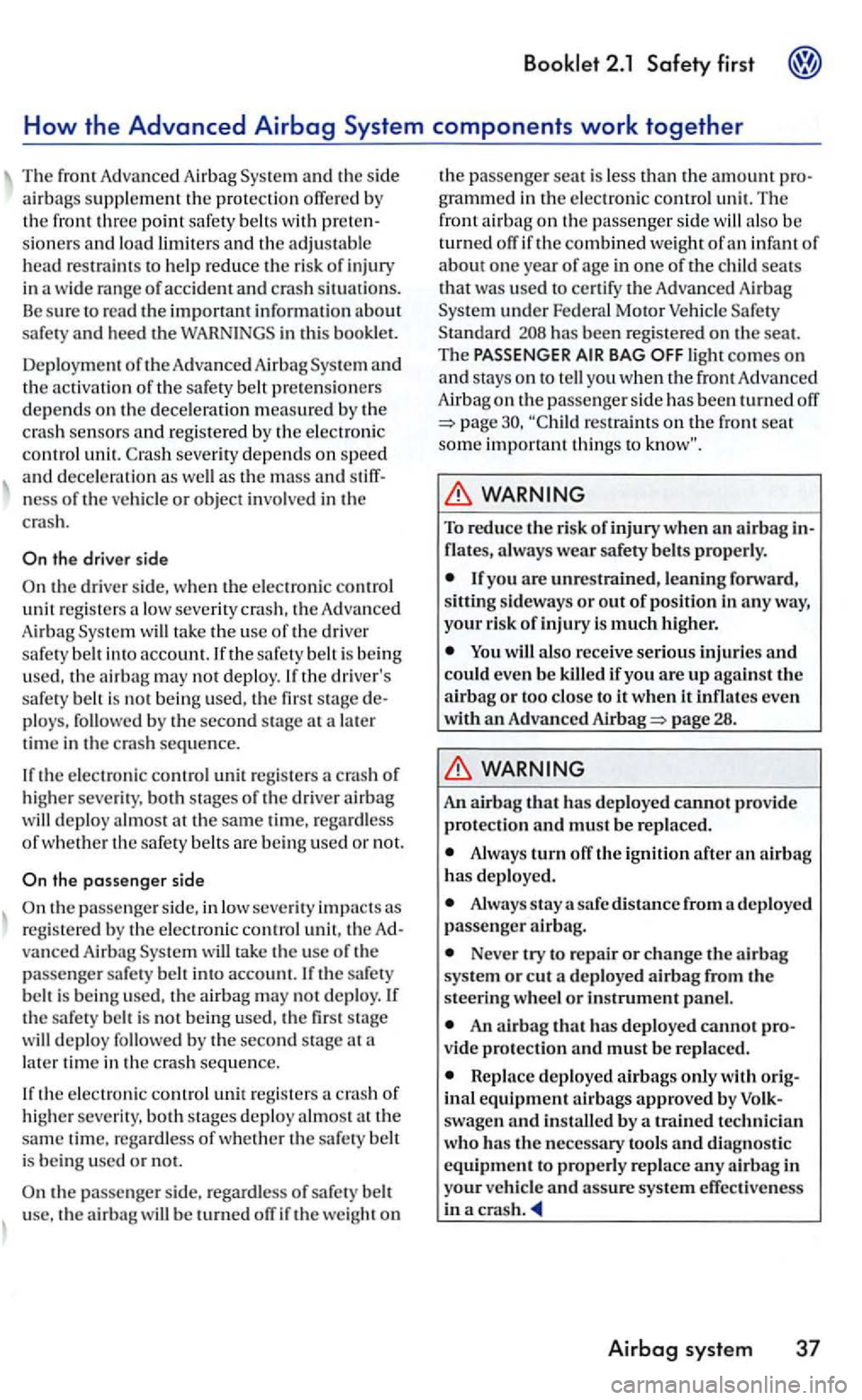
severity de pends on sp eed and d ece lemtion as well as the mass and n ess of the vehicle or object involved in the
cras h.
plo ys. follo wed by the second stage at a lat er
t im e in the cras h sequence.
If t
he ele ctronic co ntrol unit regis ters a cras h of
high e r seve rity, both stages of th e drive r a irbag will d eplo y almost at the same time, rega rd less of w he th er th e safe ty belts are bein g used or not.
gramm ed in the e lec tron ic co ntrol unit. The front airba g on the passenger side will also be
turned off if th e combined weight of a n infant of about one year of age in one of th e child seats
that wa s use d t o ce rtify the Advanced Airbag Sys te m under Federa l Moto r Vehicle Safety
S tandard has bee n regi ste re d on th e seat. The
res traint s on the front seat some important things to
flat es, always wear s afety belt s properly.
If yo u are unres trained , leaning forward,
s itting sideways or out of position in any way, your risk of injury is much higher.
28.
An airbag that has deplo yed cannot provide protecti o n and must be replac ed.
Alway s turn off the ignition after an airbag has deployed.
safe distance from d eplo yed passenge r airbag.
N ever try to repair or change the airbag s ys te m or c ut a deployed airbag from the
s teering wheel or in strument panel.
An airbag th at h as deployed cannot vid e protection and must be re placed.
Repla ce deployed airbags only with ina.l equipment airbags approved by swagen and in sta ll ed by a train ed t echnician who has the necessa ry tools and diagno sti c equipment to properly replace any airbag in
your ve hicle and assu re syste m effectiveness in a cra sh
Airbag system 37
Page 200 of 444
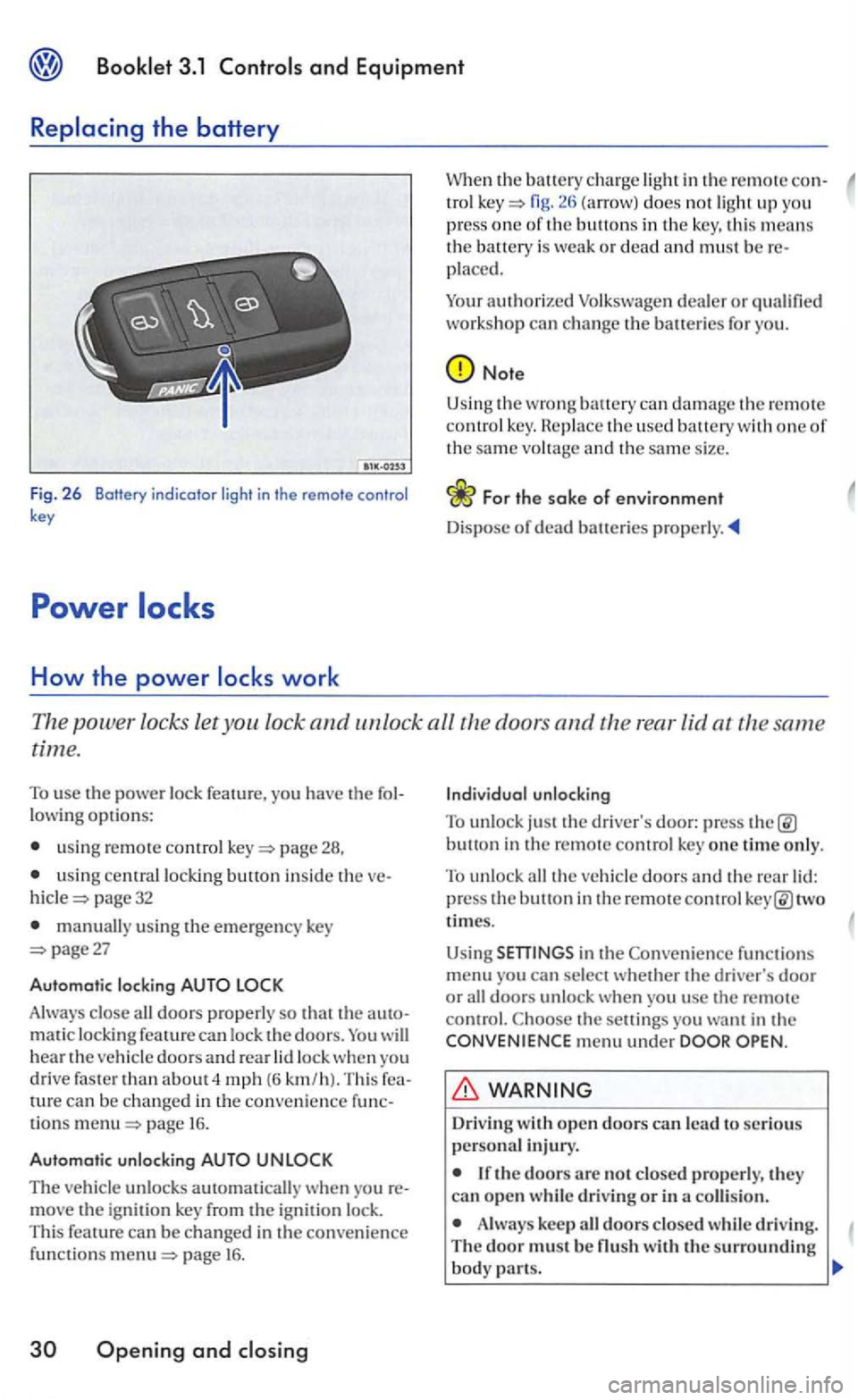
and Equipment
Fig. 2 6 Botfery indicator light in the remote control key
How the power
in the remote con-tro l fig. does not ligh t up you
press one of th e buttons in the key, this means the battery is weak or dead and must be placed.
Your
authorized
Note
Using the wrong can damage t h e remote co ntrol key. th e used battery with one of the same vo ltage and th e same size.
Th e power locks let you lock and unlock all the doors and the rear lid at the same
time.
To use the power lock feature, you have the
usin g remote control page 28,
u sing central locking button inside the page 32
manually using the emergency key page27
Automatic locking
Always close all doors properly so that the matic locking feature can lock the doors. will hear the vehicle doors an d rear lock when yo u
drive faster than about 4 mph (6 km /h). Thi s can be changed in the convenience tions page 16.
Automatic unlocking
The vehicle unlocks automatically w hen yo u move the ignit ion key from the ignition lock.
This feature can be changed in the convenience funct io ns page 16 .
Openin g and
button in the remote control key one time only.
To unlock all the veh icle doors and the rear two
times.
Using
functions menu you can sel ect whether the driver's door or all doors unlock when you usc the remote control. the setti ngs you want in the menu under
Driv ing
Always keep all doors closed whil e driving. The door must be
Page 273 of 444
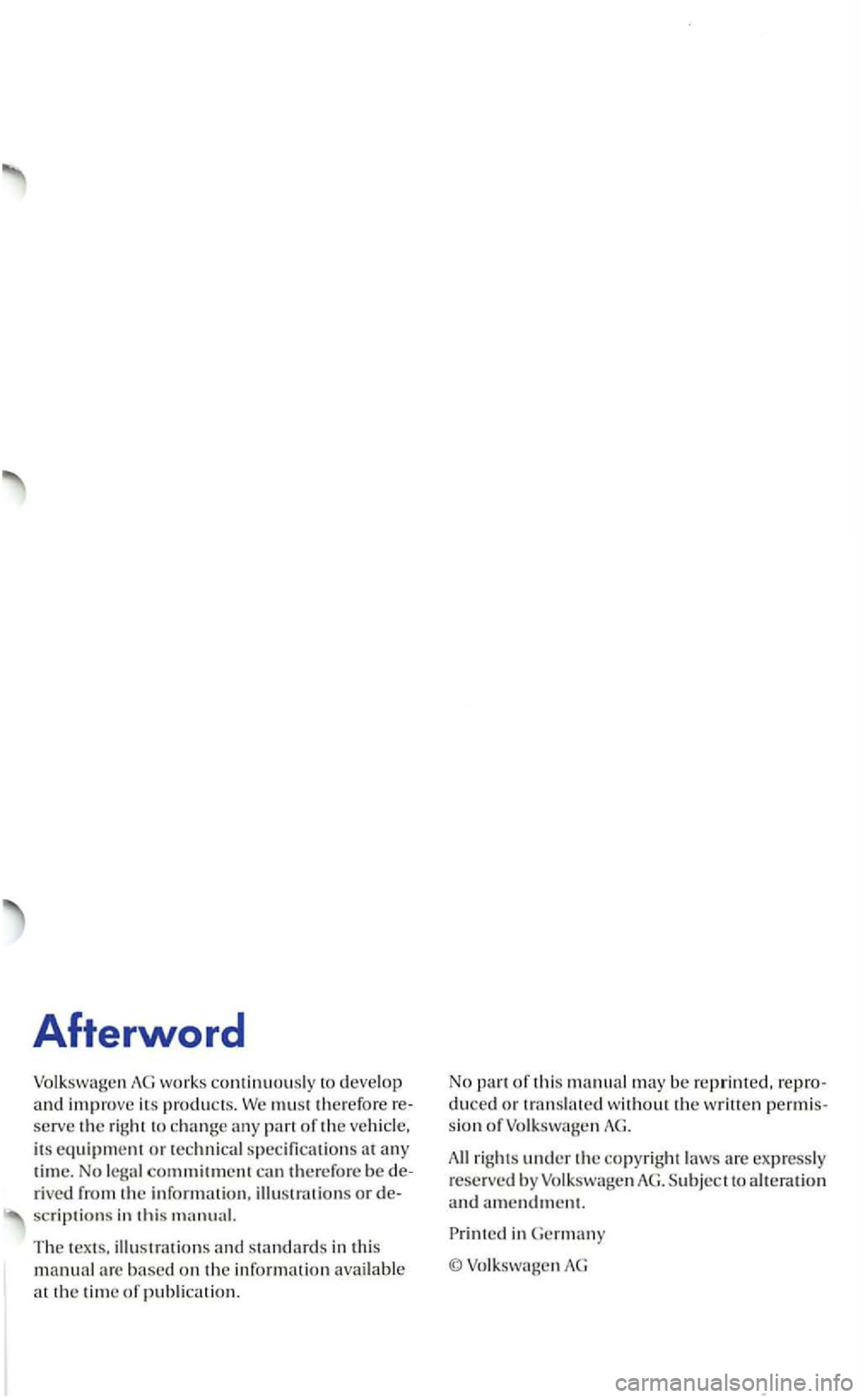
Afterword
AG works contin uo usly to develop
a n d improve its produc ts . We mus t therefore re serve the ri ght to change any part of th e veh icle,
its
equipme nt or specification s at any time. N o commitment therefore be derived from th e inform ation. illu strations o r descriptions in this m an ual.
T he te xt
s. illu stratio ns and standards in t his manual arc on the info rmatio n available at the time o f publica tion.
No of thi s
AG.
All rights under the copyright laws are expressly reserved h y AG. to alteration and amendment.
in Germany
AG
Page 282 of 444
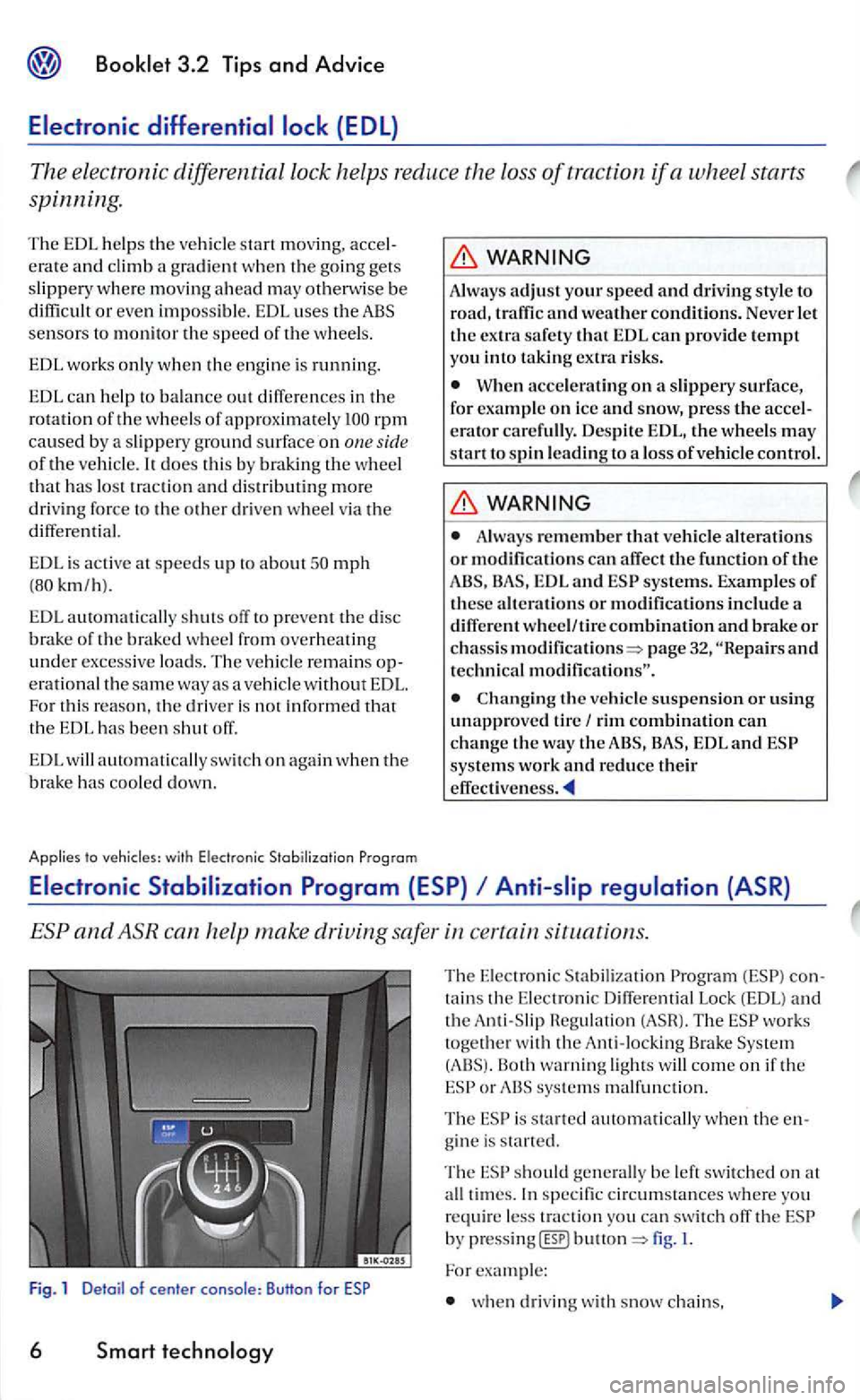
does th is by braking the whee l that h as lo st trac tion an d dis tributing more
driv ing force to the other driven wheel via the differen tial.
EDL i s active at speed s up to about mph
not that the EDL has been shut off.
EDL wi
ll automatically switch on again when the brake
Always adjust your speed and driving style to
road,
When accelerating on a slippery surface,
for example on ice and snow, press the accelerator carefully_ Despit e EDL, the wheels m ay
start t o spin leading to a loss of vehicle control.
Always remember that vehicle alterations or modifications can affect the function ofthe EDL and
page 32, and te chnical m odifications".
Changing the vehicl e s uspension or using unapproved tire rim combination can
change the way the EDL and systems work and reduce their e ff ectiveness_
6 Smart
The E lectronic Stabilization con
tai ns the E lectronic Differential Lock (EDL) and the Anti- S lip Regulation (ASR). The
or sy s te m s malfunction.
The is sta rted automatically when the engine is started.
The should generall y be left switched on at
all times. In specific circumstances where yo u
requ ire less by l.
For exampl e:
whe n driv ing w ith snow chains,
Page 313 of 444
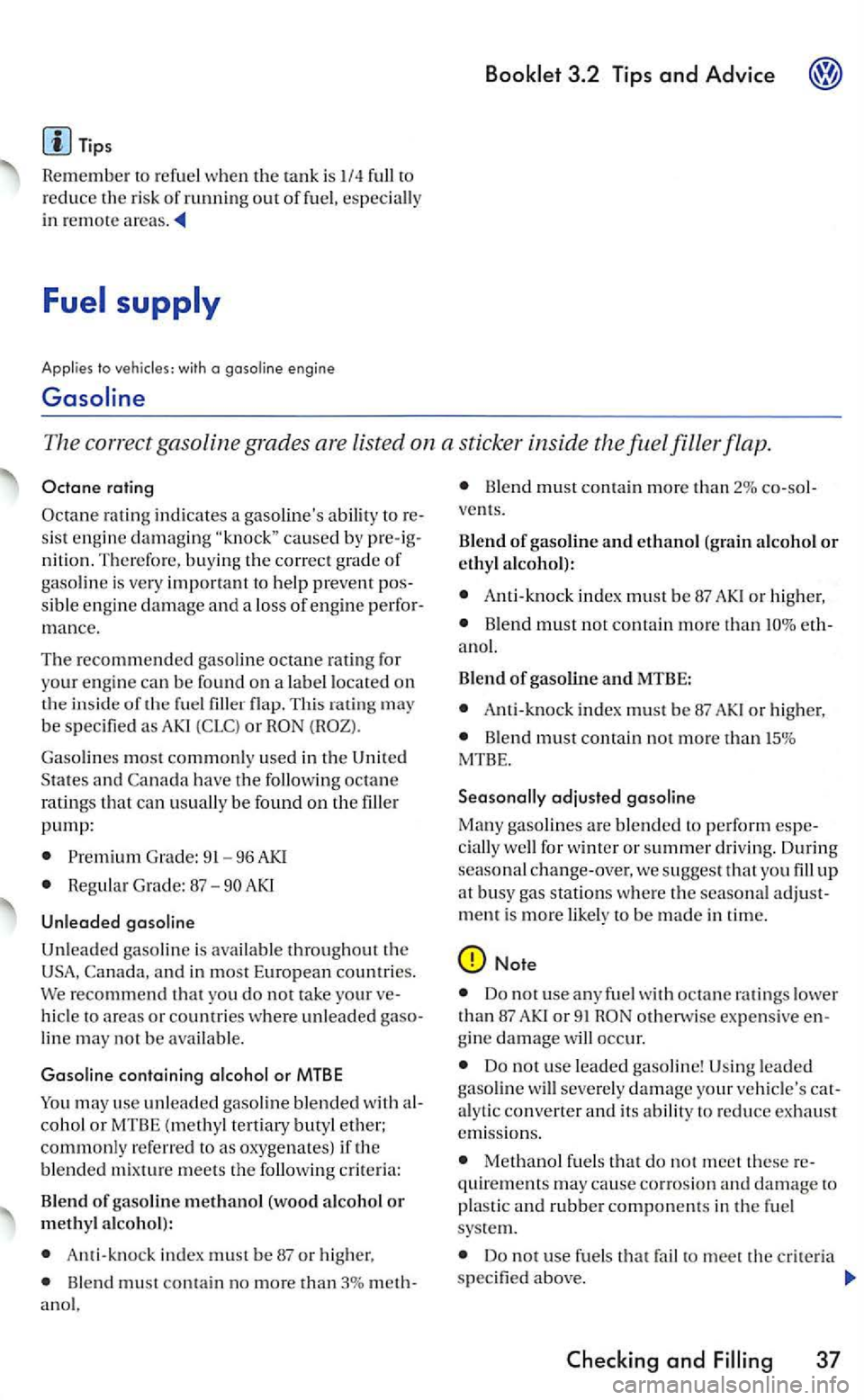
Tips
Remember to refuel w hen the tank is 1/4 full to reduce the risk of running out of fuel, es pecially in remote areas.
Applies to vehicles: with a gas oline engine
The correct gasoline grades are listed on a sticker inside the fuel filler flap.
rating
Oc tane caused by pre-i g
n it ion . Th ere fore, buying th e correct grade of gasoline is very important to help prevent possibl e engine damage and a loss of engine performance.
The recommended gasoline octane ra ting for
your e n g in e can be found on a label lo cated on the in sid e o f the fuel flap. This ratin g m ay be specified as (CLC) or
Grade: 91-96 AKI
Regular Grade: 87-90
Canada, a nd in most European countries.
We recommend that you do not take your ve
hicl e to areas or countries where unleaded gasoline may not be available.
Gasoline containing alcohol or MTBE
You may us e unleaded gasoline blended withalcohol or MTBE (methyl tertiary butyl ether; commonly re fe rr ed to as oxygenates) if the
b lende d mi xture meets th e following criteria:
B
lend of gasoline methanol (wood alcoho l or methyl a lcohol):
A nti -knoc k ind ex must be 87 or higher,
methanol.
An ti-k nock index must b e 87 or higher,
Blend must not contain mor e t ha n ethanol.
Blend of gasoline and MTBE:
Anti-knock ind ex must be 87 or high er,
Blend must conta in not more than 15%
MTBE .
Seasonally adjusted gasoline
Many gasolines are blended t o perform especially well for winter or summe r driv in g. During
seasonal change -over, we sugges t th at you fill up
at busy gas stations where th e seasonal adjustment is more like ly to be made in time.
Note
Do not use a ny fu el with octane lower than 87 or 91
Do not use leaded gasoline! U sin g leaded gasoline will seve re ly damage your vehicle's catalyt ic conver te r and its ab ility to reduce exhaust emissions.
Methanol fuels that do not meet these re quirements may cause corrosion and damage to plast ic and rubbe r component s in the fuel
sys tem.
Do not use fuels that fail to meet the c rit eria specified above .
and 37
Page 330 of 444
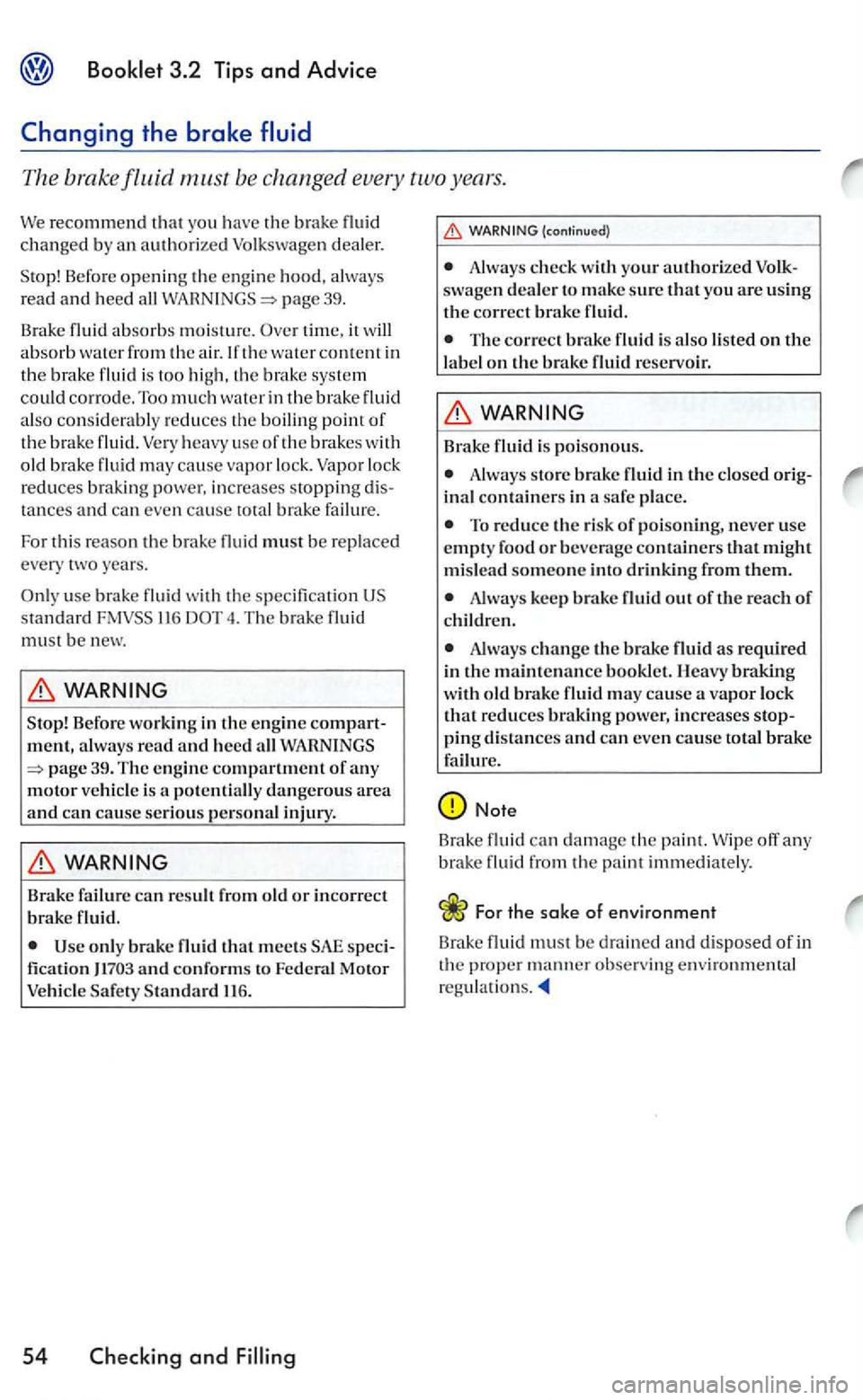
3.2 Tips and Advice
The brake fluid be changed every two years.
We recommend that you have the brak e changed b y an authorize d Volkswagen dealer.
S top! Be
fore openin g th e e ngin e hood, always
read and heed all page 39.
Brake fluid
absorbs m oisture. time, it will absorb wate r from the air. the wa ter content in the brak e fluid is too high, the brake sys te m
c
ould corrode. Too much wa te r in the brak e fluid
a lso consid erably reduces the boilin g point of the brake fluid. Very heavy use of th e brak es with
old brake fluid may cause vapor lock . Vapo r lock
reduces braking power, in cre ases stopping tances and can eve n cause total brake failu re.
For this r
eason the brake fluid must be repla ced
every two years.
use brak e fluid the s pecification U S standard 116 4. The brake fluid must be new.
Stop ! Befor e working in the engine compartment, always read and h eed all WARNINGS 39. The engine compartment of any motor vehicl e is a potentiall y dangerous area and can cause seriou s persona l injury .
Brake failure can result from old or incorrect brake fluid.
fica tio n
(continued)
A lwa ys check with your authorized swage n deale r to make sure that you arc u sing the correct brake fluid.
The correct brake fluid is also listed on the
labe l on the brak e fluid reservoir.
Always store brake fluid in the closed
To reduce th e risk of poisoning, neve r us e empty food or beverage containers that mi ght mislead someone into drinking from them.
A lwa ys keep bra ke flu id out of the reach of childr en.
Alway s change th e b rake fluid as required in the maintenance bookl et. Heavy braking w ith old brake fluid may cause a vapor lock that reduces braking power, increases ping distances and can even cause tota l brake failure.
Note
Brake fluid can damage the pai nt. Wip e off any
brake fluid from rh c paint immedia tely.
For the sake of environment
B rake fluid
must be drained and disposed of in
th e proper manner obse rv ing env ironmental
Page 335 of 444
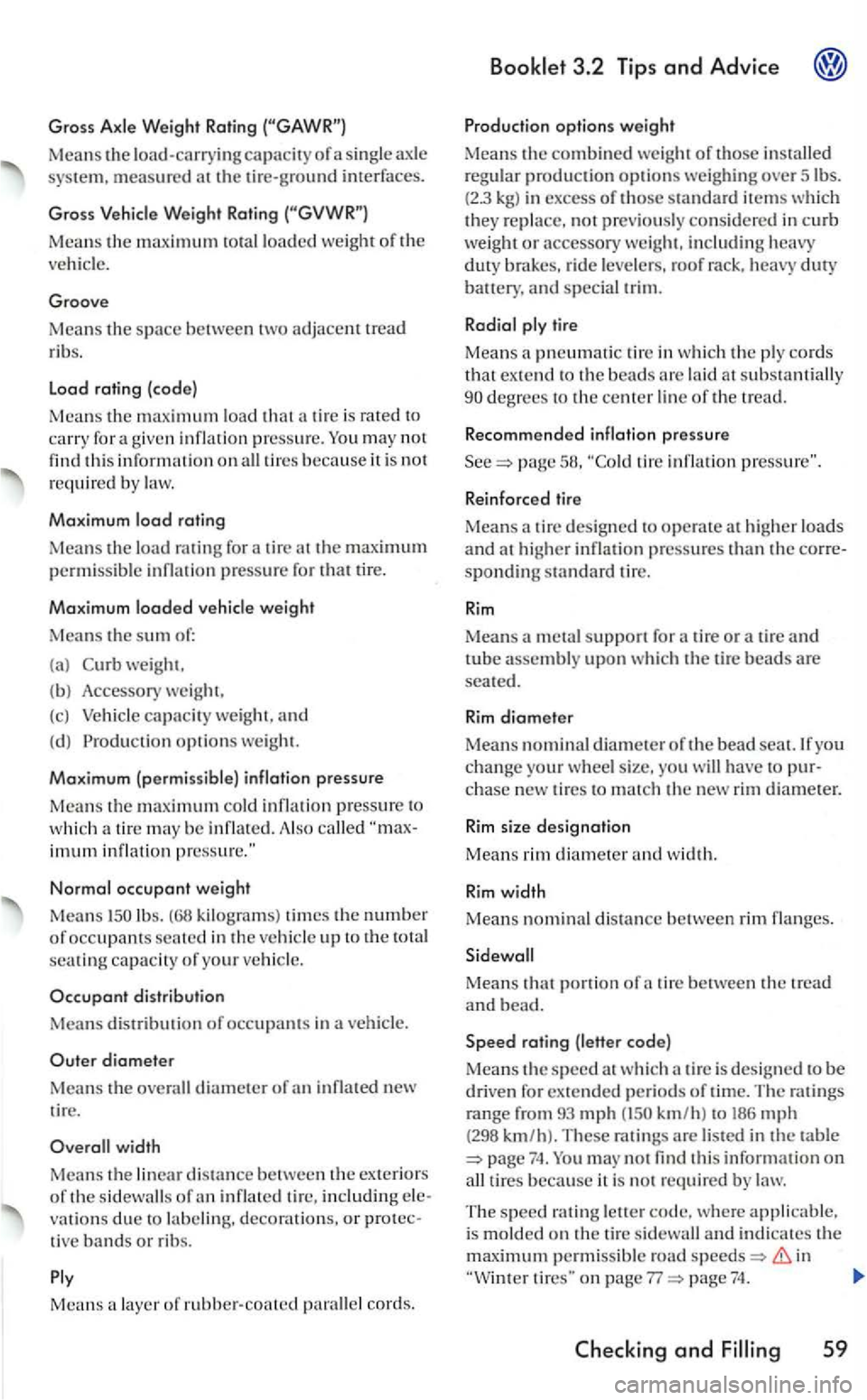
Gross Axle W eight Ra ting
Mea ns the load-carryin g capacity of a sing le ax le
Mean s th e maximumlOtalloaded weight of the
ve hicle.
Groove
Means the space between adjacent tread
r ib s.
L
oad ratin g (cod e)
Means the load th at a tire is rated to
carry for a give n inflation pressure. You may no t find thi s information o n all tires because it is not require d b y
Maximum load ratin g
Means the load rating for a tire the m aximum permiss ib le inflation p ressure for that tire.
Maximum loaded vehicle weig ht
Means th e sum of:
( a)
weig ht.
( b ) Accessory
weight,
(c) Vehicl e capacity weig ht. and
(d ) Production o pti ons
b e inflat ed. A lso called imum inflatio n pressure."
Normal oc cupant weight
Means lb s. kilog ra ms} times the n u m ber of occupants sea te d i n the ve hicl e up to the seating capacity of your vehicle.
O c
cupant distr ib ution
Means dist ributio n of occupants in veh icle.
Outer d iameter
Means the overall diameter of an inflated new tir e.
inflated including vations due to or tive bands or rib s.
P ly
M
ean s layer uf parallel cord s.
Productio n optio ns weight
Means the com bined weight of those installed
regular produc tion options weighing over Sibs. (2.3 kg) in excess of those standard items whic h they replace, not previously considered in curb weight or accessory
pne u matic tire in which the pl y cords th at ex tend to the beads a rc laid at substa n tially degrees to the center lin e of the tread.
Re commended inflat io n p ressure
page tire inflation p ressure".
Reinforc
ed tir e
Means a tire designed to operate at higher loads and at higher inflation pressures than the sponding tire.
Rim
Means a m etal support for a tire or a tire and tube assembly upon whic h the tire beads are seate d .
Rim d iameter
Means nominal diameter oft he bead seal. you change your w heel size. you will have to
Means that portion of tire between the tread
and bead.
which
km/h) mph ( 298 k.m/ h ). These rat ings are lis ted in the table 74. You may not find this information on all tire s because it is not required by law.
The speed r ating lett er cod e, where is molded on the tir e s idewall and indicates the maxjmurn permissible road in on page 77 74.
Checking and
Page 344 of 444
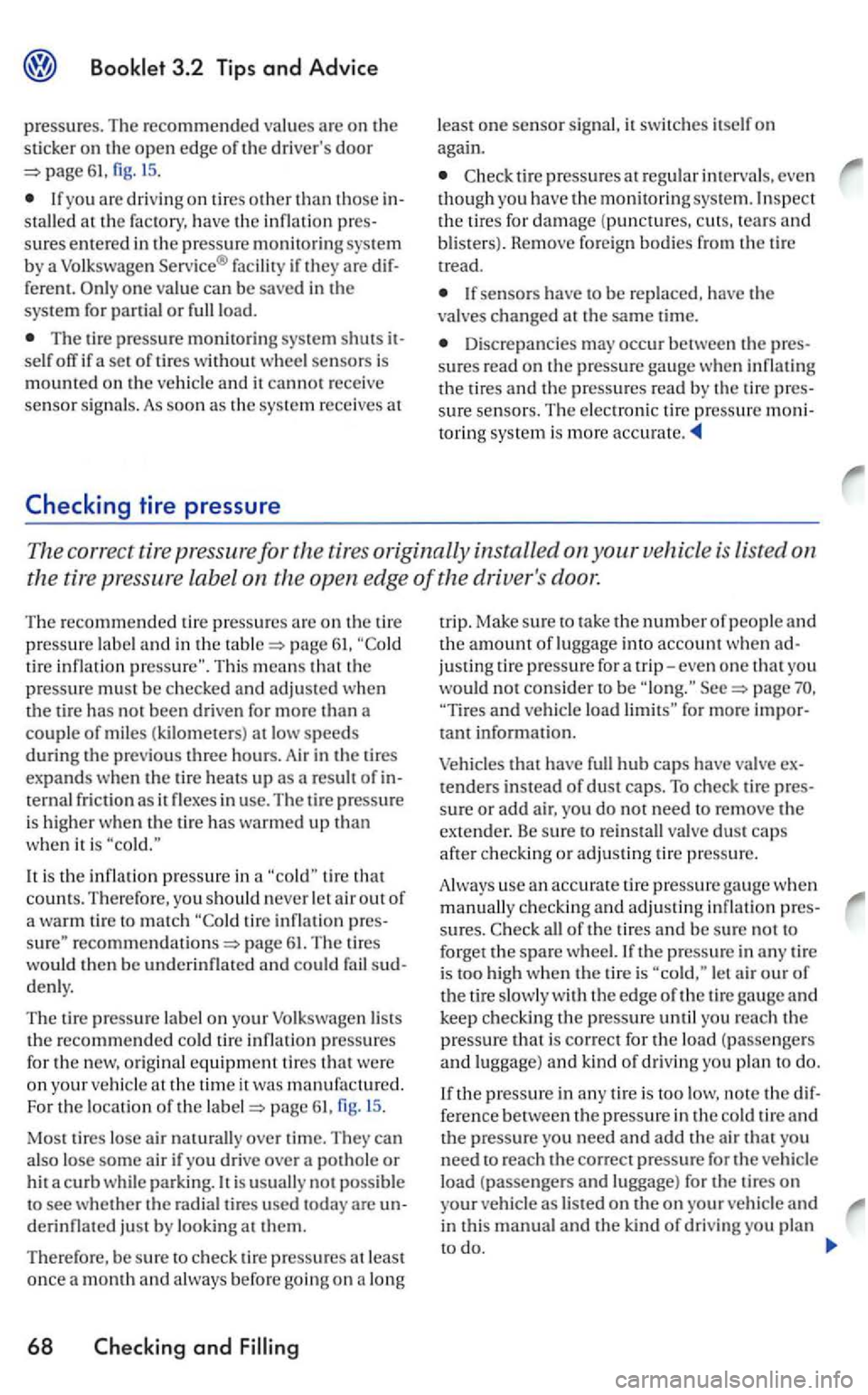
3.2 Tips and Advice
pressures. The recommended values are on the
s ticker on th e open edge of the driver's door 61, fig. 1 5 .
yo u are driving on tire s other than those in
s tall ed at the factory, have the inflation pres
sures entered in the pressure monito rin g sys te m by a Volk sw agen Serv ice® fac ilit y if they are dif
ferent . O nl y one va lue can be save d in the syste m for partial or full load.
The tire pressure monitoring sys te m shuts itself off if a se t of tire s w ithout wheel sensors is mounted on the vehicle and it cannot receive sensor s ignal s. As soon as th e sys te m recei ve s at
tir e press ures at regular interva ls. even though yo u have the monitoring sys te m. Inspect the tire s for damage (punctures. cuts. tears and blister s). Remove foreign bodies from the tire
tread .
sensors have to be repla ced. have the valve s changed at the same time.
Discre pancies may occur betwee n th e pres
sures read on the pressure gauge when inflating the tires and the pressure s read b y the tire pres
sure sensors. The e lectroni c tire pressu re moni
torin g sys te m is more accurate.
The corr ect tire pressure for the tires originally installed on your vehicle is Liste d on
th e tire pr
essure label on the open edge of the driver's door.
The recommended tire pressure s arc on the tire
pres sure lab el and in the page 6 1, T hi s means that the pressure must be c hecke d and adjusted w hen tire has not been driven for more t han a couple of miles (k ilometers ) at low speeds during the previo us three hours. Air in the tires
expands when the tire heat s up as a result of in
ternal friction as it flexes in use. The tire pressure is high er w he n the tir e has war med up than when it is
tir e that counts. There for e, you should nev er le t a ir out of
a warm tir e to matc h p a ge 61. The tire s
would the n be underinflatcd and could fail sud
denly.
The tir e pressure la b e l o n your Volkswagen lists the recommended co ld tire inflation pressures for the new, orig in al equipment tires we re on yo ur ve hicl e at the tim e it was m anufa ctured.
For the location of the page 61, fig . 15 .
Most tir
es lose air naturally over time. They can
also lose some air if you drive ove r a pothole or h it a c urb whil e pa rking. is usually not possible
t o see w hether the radia l tires u se d today are un
derinflated jus t b y looki ng at them.
Therefore, be sure to check tire pressur es at least once a month and always be for e goin g on a lo ng
68 Checking and
trip. Mak e sure to ta ke the numbe r of p eople and the amount of lu ggage into ac count whe n ad justing tire pressure for a trip -eve n one that you wou ld not consider to b e page and ve hicle load for more important information.
Vehicles that h ave full hub caps have va lve ex
t ende rs in stead of dust caps. To ch ec k tire pressure or add ai r. yo u do not need to remove the
extender. Be sure to re in stall v a lve dus t cap s
aft er checkin g or adjustin g tir e pressure.
A lways use an
accurate tire pressure gauge whe n manually c hecking and adju sting inflatio n pres -sures.
let air our of the tire slowly with the edge of the tir e and keep checkin g the pressure until you rea ch the pressure that is correct for the load (passenge rs
and lu gga ge) and kind of dri vin g yo u pla n to do.
th e pressure in an y tire is to o low, no te the dif
fere nce be tween the pressure in the co ld tir e and the pressure you need and add the air that yo u
need to r e ac h the correc t p res sure for the ve hicle
lo ad (passengers and luggage) for the tires on
your ve hicle as listed on the on your ve hicl e and in thi s manual and th e kind of dri vin g yo u plan